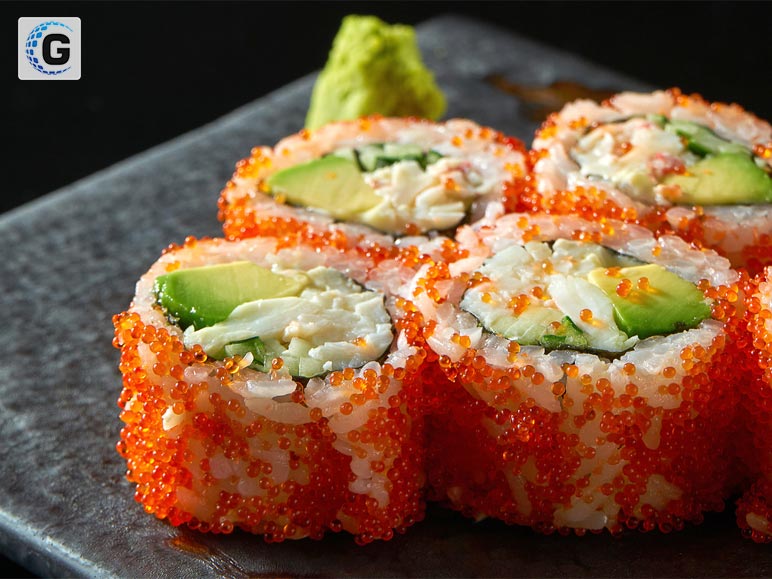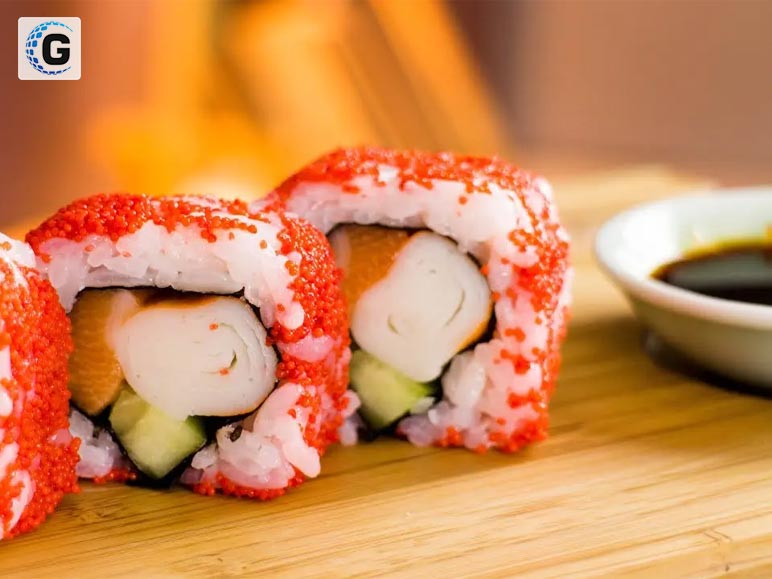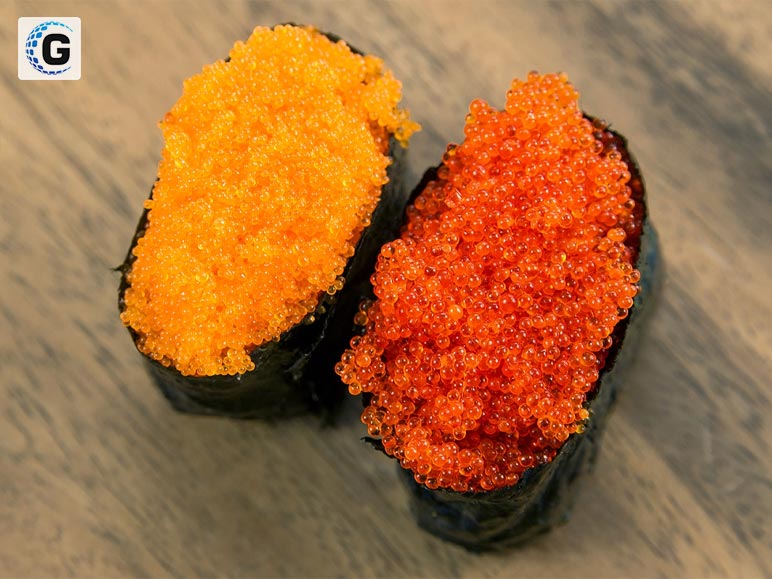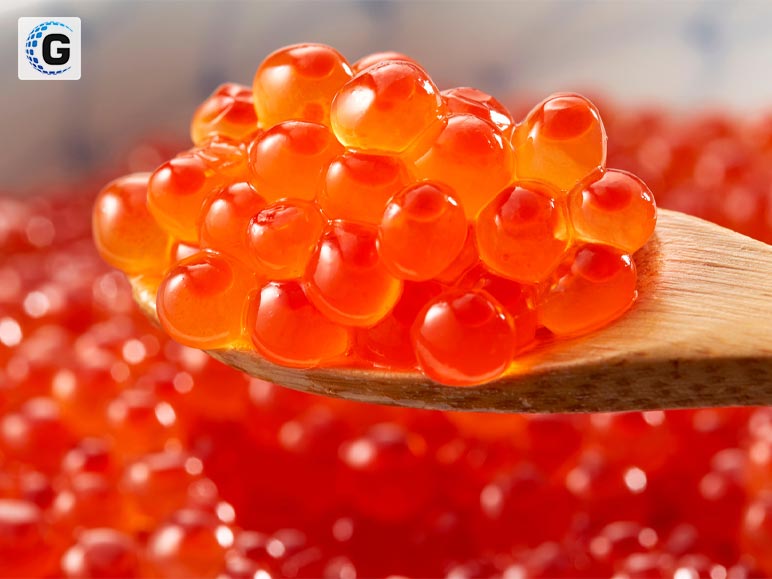With regard to sushi, each ingredient contributes its own novel touch. Among the small, popping bursts of flavor, Tobiko and Masago stand out as the tiny pearls that improve the sushi experience. These small fish roes could appear to be similar at first look, however, they have distinctive qualities that set them apart. How about we jump into the subtle yet significant differences between Tobiko and Masago, unlocking the secrets behind these sushi delicacies?
What Is Tobiko?

Tobiko, the roe of flying fish, presents a lively burst of colors, ranging from searing orange to dark red. Its size is rather larger than Masago, and gnawing into one of its beads gives you a satisfying crunch. Adding a bit of sweetness, texture, and a trace of saltiness to sushi, Tobiko is notable for its typical and rich flavors. One normal decision for garnishing sushi rolls is scallions because of their solid structure, which assists them with retaining their shape.
What Is Masago?

Masago, then again, is a smaller fish with a more touchy texture that comes from the roe of capelin fish. Masago can be portrayed as having a gentler flavor profile than Tobiko, and its tones can range from translucent orange to light yellow. Its smaller grains give a smoother mouthfeel, almost melting on the tongue, and it often gets used as a topping or mixed into sushi fillings to infuse a delicate maritime essence.
Tobiko vs Masago- How Do They Differ?

You know now what masago is in sushi. Let’s have a look at the difference between Tobiko and Masago.
Size Matters
One of the critical differences between Tobiko and Masago is their size. Tobiko tends to be bigger in grain size contrasted with Masago, offering a more articulated texture when consumed. The smaller grains of Masago, while still providing a magnificent pop, convey a subtler encounter on the palate.
Color Palette
While both Tobiko and Masago arrive in a variety of colors, Tobiko tends to have bolder and more profound hues, ranging from radiant orange to red. Masago, then again, showcases softer and lighter shades, leaning towards translucent orange or yellow. The visual contrast they offer on sushi rolls adds an aesthetic allure to the dish.
Flavor Profiles
Tobiko and Masago possess distinct taste profiles. Tobiko has a more grounded, saltier flavor with a hint of typical sweetness. Contrary to popular conviction, Masago adds a slight brininess and a softer flavor to sushi, allowing it to harmonize with different fixings without dominating the overall flavor.
Sushi With Masago
Masago does a variety of occupations in the sushi business. As a garnish, it gives sushi rolls a splash of variety and a hint of flavor. In addition, chefs often use Masago with fillings like California rolls or spicy tuna, giving the dish a deliciously maritime flavor.
Presence Of Tobiko
Tobiko is most of the time utilized as a garnish or topping for sushi because of its large size and firm texture. It is an incredible decision for supporting the visual appeal and textural feel of sushi rolls because of its ability to retain its shape and communicate a pleasing crunch.
Masago Sauce: A Culinary Masterpiece
Masago sauce is perhaps their most famous creation. Masago, mayonnaise, and different fixings are mixed to create a creamy, marginally briny sauce that is very flavorful. It sprinkles a creamy extravagance and blast of maritime flavors over sushi rolls, making them seriously appetizing.
Sushi Rolls That Are Innovative
Adding to the perpetual variety of sushi rolls, Tobiko and Masago improve the dish with their imaginative mix of flavors and textures. Chefs often use Tobiko to make eye-catching sushi rolls, for its dynamic color as well as for the satisfying crunch it provides. Masago, with its more subtle flavor profile, proves to be a superb buddy in rolls where a subtle clue of the sea is desired without overpowering other ingredients. As these tiny fish roes adorn sushi rolls, they transform each chomp into a wonderful symphony of taste and texture.
Masago Mayo Dynamite
One brilliant blend that showcases the versatility of Masago is the Masago Mayo Dynamite. This flavorful sauce involves blending Masago with creamy mayonnaise, creating a luscious topping that elevates sushi higher than ever. The creamy texture of the mayo complements the fragile pop of Masago, resulting in a burst of umami that coats the palate. This powerful sauce is often used to upgrade the richness of dishes like heated rolls or as a dipping sauce for sushi, offering a great contrast to the freshness of the seafood.
Tobiko Tempura Surprise
Tobiko’s bigger grains and firm texture make it a welcome expansion to tempura dishes. Tobiko adds a firm layer that encases the delightful fish or veggies inside when utilized as a coating for tempura. An extraordinary differentiation of textures is presented by the explosion of Tobiko with each bite, hoisting the culinary experience of tempura dishes.
Fusion Delights With Masago
For fusion dishes that consolidate a few culinary practices, Masago is the ideal fix because of its nuance. Masago-infused sauces and dressings can supplement conventional Japanese sushi dishes or find their direction in dishes that are enlivened by different cuisines. The delicate pop of Masago might hoist servings of mixed greens, poke bowls, or even tacos roused by sushi, demonstrating its flexibility past customary sushi rolls.
Conclusion

Tobiko and Masago are little yet critical parts that raise the entire dining experience in the realm of sushi. In the art of sushi production, their extraordinary size, color, texture, and flavor put them aside and make them imperative. These minuscule fish roes give a blast of flavors that supplement sushi in their own special ways, whether it’s major areas of strength for Masago or the delicate smash of Tobiko.
Also Read:
- How To Earn Using FeetFinder?
- How To Start Logo Design Business?
- 5+ Effective Blackhead Removal Tips
- Internal Linking For SEO: The Ultimate Guide
- Can You Get A Burst Fade With Straight Hair?

